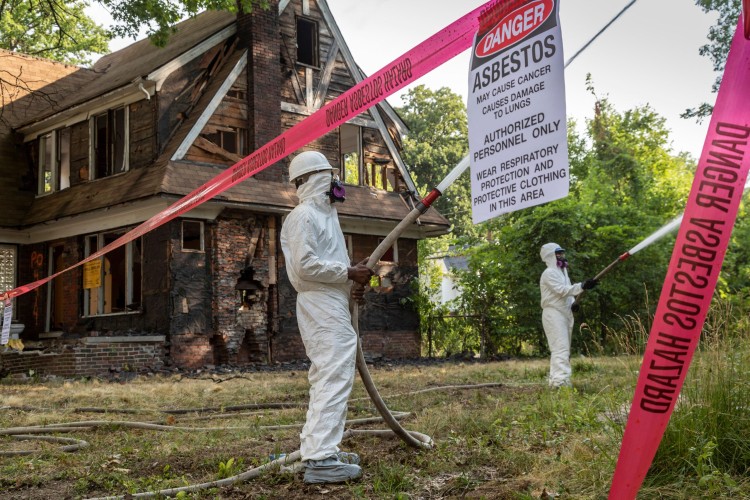
Asbestos, a once widely used material, poses significant health risks when present in homes.
Its microscopic fibers, when inhaled, can lead to serious respiratory diseases, including lung cancer and mesothelioma.
The danger lies in the fact that asbestos-containing materials may still exist in older homes, particularly those built between the 1950s and the 1980s.
If you suspect the presence of asbestos in your home, it is crucial to take immediate action to protect yourself and your family from potential harm. Ignoring or delaying addressing the issue can expose you to long-term health risks.
In this article, we will outline the necessary steps to take if you suspect asbestos in your home, ensuring your safety and peace of mind.
The Steps to Effective and Safe Asbestos Removal
Step 1: Educate Yourself
To effectively deal with asbestos in your home, it is crucial to educate yourself about this hazardous material. Asbestos is a naturally occurring mineral fiber that was commonly used in building materials for its fire-resistant and insulating properties.
It can be found in various areas of homes, such as insulation, ceiling tiles, floor tiles, pipe insulation, and textured coatings. Understanding the potential sources of asbestos in your home is essential for identification and proper management.
Equally important is comprehending the health risks associated with asbestos exposure. Inhalation of asbestos fibers can lead to serious respiratory conditions, including lung cancer, asbestosis, and mesothelioma. It is vital to recognize the symptoms and long-term effects of asbestos-related diseases.
To further enhance your knowledge on the subject, there are numerous resources available, including government health agencies, environmental protection organizations, and asbestos awareness websites. These sources provide valuable information and educational materials to help you navigate the complexities of asbestos in your home and make informed decisions for the well-being of yourself and your loved ones.
Step 2: Look for Signs of Asbestos.
When suspecting the presence of asbestos in your home, it is important to be able to identify potential sources of asbestos-containing materials (ACMs). Common materials that may contain asbestos include insulation, vinyl flooring, textured ceilings, and pipe insulation.
However, it is crucial to note that visual inspection alone cannot confirm the presence of asbestos, as it requires proper testing by professionals. Nevertheless, there are visual indicators that can raise suspicion, such as the presence of crumbling or deteriorating materials, disintegrating insulation, or older construction materials used in your home.
Being aware of these potential asbestos hazards empowers homeowners to take the necessary precautions and seek professional guidance. If you come across any materials that you suspect may contain asbestos, it is advisable to refrain from disturbing them and seek professional asbestos testing and evaluation to ensure accurate identification and appropriate management of the situation.
Step 3: Consult with Professionals.
When dealing with suspected asbestos in your home, it is crucial to seek professional assistance for proper testing and assessment. Professional asbestos testing companies or environmental consultants have the expertise and equipment to accurately identify and assess the presence of asbestos in your home.
They can conduct thorough inspections, collect samples, and send them to certified laboratories for analysis. It is essential to choose reputable professionals who are certified and experienced in asbestos testing and abatement.
To find reliable experts, consider seeking recommendations from local health departments, environmental agencies, or trusted contractors. Professional guidance is of utmost importance when dealing with asbestos issues as it ensures the proper handling, management, and removal of asbestos-containing materials. Their expertise minimizes the risk of exposure and ensures compliance with safety regulations, protecting the health and well-being of you and your family.
Step 4: Develop a Removal Plan.
Developing a comprehensive asbestos removal performed by professionals plan is crucial when dealing with asbestos in your home. It provides a structured approach to address the issue effectively and safely.
Considerations must be made regarding the complexity of the asbestos-containing materials (ACMs), the extent of contamination, and the available resources. While some homeowners may consider DIY removal, it is essential to weigh the risks and challenges involved.
DIY removal may not be suitable for all situations, especially when dealing with significant asbestos contamination or materials that require specialized equipment or expertise. In almost every case, hiring a professional contractor experienced in asbestos removal is highly recommended.
Regardless of the approach, it is imperative to follow local regulations and safety guidelines. Local authorities often have specific requirements for asbestos removal, including permits, proper disposal procedures, and compliance with safety protocols.
By developing a removal plan and adhering to these regulations and guidelines, you ensure the safe and effective removal of asbestos from your home, minimizing the risk of exposure to harmful fibers and protecting the health of yourself and your loved ones.
Step 5: Implement Safety Precautions.
Implementing safety precautions is paramount when handling potential asbestos materials. Personal protection is crucial to minimize the risk of asbestos fiber inhalation.
It is essential to wear appropriate personal protective equipment (PPE), including disposable coveralls, gloves, respiratory protection, and eye protection. Additionally, containment measures should be implemented to prevent the spread of asbestos fibers during removal.
This may include sealing off the work area with plastic sheeting, using negative air pressure systems, and employing wet methods to suppress dust.
Proper disposal procedures are equally important to ensure the safe handling and disposal of asbestos-containing materials. Local regulations dictate specific requirements for packaging, labeling, and disposing of asbestos waste. It is crucial to adhere to these guidelines and work with licensed waste disposal facilities to prevent the contamination of the environment and protect the health of others.
By implementing these safety precautions, you can minimize the risk of asbestos exposure and promote a safe working environment throughout the removal process.
Step 6: Hire a Professional Contractor.
When it comes to asbestos removal, hiring a licensed and experienced asbestos removal contractor is highly recommended. Professionals have the necessary knowledge, skills, and equipment to safely and effectively handle asbestos-containing materials (ACMs).
When selecting a contractor, it is important to do thorough research and consider their qualifications, certifications, and track record. Seek recommendations from trusted sources and obtain multiple cost estimates to ensure a fair price.
A reputable contractor will conduct a thorough assessment, develop a comprehensive removal plan, and follow strict safety protocols to protect both the workers and the occupants of the property.
Hiring professionals for asbestos removal offers numerous benefits, including expertise in handling different types of ACMs, adherence to safety regulations, proper disposal of hazardous waste, and efficient completion of the project.
By entrusting the task to experienced professionals, you can have peace of mind knowing that the asbestos removal will be done safely and effectively, minimizing the risks associated with asbestos exposure.
Step 7: Monitor the Removal Process.
Ongoing monitoring is crucial throughout the asbestos removal process to ensure its effectiveness and safety.
This includes conducting air quality testing to assess the presence of asbestos fibers in the air. Regular inspections should also be carried out to verify the thoroughness of the removal and confirm that all identified asbestos-containing materials (ACMs) have been properly addressed.
Monitoring allows for the identification of any potential issues or areas that may require further attention. Homeowners should actively participate in the monitoring process, asking questions and seeking updates from the contractor to ensure that the removal is being conducted according to the agreed-upon plan.
Once the removal process is completed, it is essential to verify the completion and obtain proper documentation from the contractor as proof that all asbestos has been removed. By actively monitoring the removal process, homeowners can have confidence in the safety and effectiveness of the asbestos removal and protect themselves and their families from potential health hazards.
Don’t Risk Your Safety When it Comes to Asbestos
When it comes to suspecting asbestos in your home, taking immediate action is vital. By following the key steps outlined in this guide, you can navigate the process effectively and protect yourself and your loved ones from the health risks associated with asbestos exposure.
Educating yourself about asbestos, looking for signs of its presence, consulting with professionals, developing a removal plan, implementing safety precautions, hiring a professional contractor, and monitoring the removal process are all critical in ensuring a safe and successful asbestos removal project.
It is crucial to prioritize safety and seek professional assistance throughout the process to ensure proper handling, disposal, and compliance with regulations. By taking prompt action, you can create a healthier living environment and safeguard your health and well-being.
Remember, asbestos is a serious concern, and addressing it promptly is a proactive step towards a safer home.










Author
Homesgofast com
Homesgofast.com is an international real estate portal and news source for Google news. Publishing international real estate, finance, homes and travel-related news and blogs for a targeted audience since 2002. Each news item is circulated to thousands of potential readers each day and is also available to the millions of people who sign up for Google news alerts. Find homes offered for sale and to rent direct from owners and some of the best real estate agents from over 35 countries